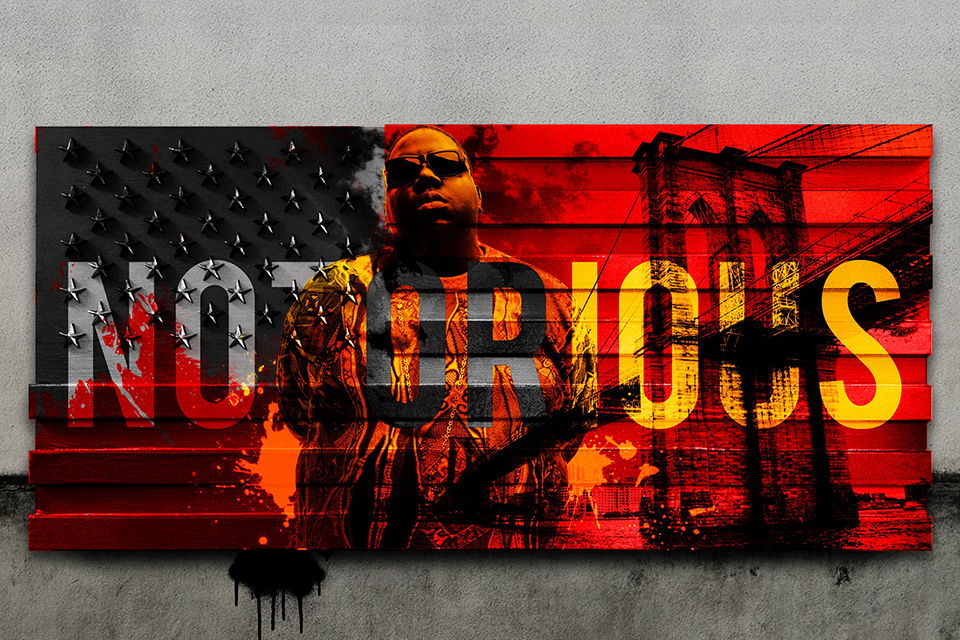While many know the iconic album cover artwork of OutKast’s Aquemini and TLC’s Fanmail, few are familiar with the man behind the art: Atlanta native D.L. Warfield.
With his latest project, the “American Flag Remix” collection, he is looking to once again bring his art to the forefront.
Using things like metal, wood, Levi’s denim, leather, iron and mercury glass, Warfield created flags to appeal both to people who criticize America and its contradictions, as well as those who embrace them. The project represents his interpretations of American life.
Having already gained interest from artists like T.I. and Usher, Warfield’s latest project promises to be a conversation starter – particularly as the political climate south of the border continues to boil.
The American flag project, me remixing it, speaks to [the fact] that … America is so many different things. America is not the same thing for every single person.

WHERE DO YOU LOOK FOR INSPIRATION FOR A PIECE OF WORK THAT YOU ARE DOING? It’s a bunch of different things, but I think the top priority is that person’s point of view or perspective, their thought process and their approach in doing things. How they approach using God-given abilities that they have, what their perspectives were and what they stood for. Naturally I’m drawn to people that are rebels, you know? People that might not be considered to be so squeaky-clean, but definitely stood up for what they believe in.
WHAT WOULD YOU SAY IS THE MOST DEMANDING PIECE YOU HAVE EVER WORKED ON? I would probably say those flags that I built. They were called The United States of These Streets. They were made of concrete and steel you know? So there was a lot of fabrication involved, it was a lot of research that went into it as far as how to make something that was built out of concrete as light as possible so that it could still hang from the wall without causing destruction.

WHAT DO YOU THINK IS THE DIFFERENCE BETWEEN FINE ART AND POP ART? To me, I don’t see a line between fine art and pop art. If I was to bundle it, I would say fine art is artwork that is made without … It’s almost like it was made out of hopes and dreams. Where it’s displayed could give it a difference, but they have the same depth.
HOW DOES AN ARTIST GO FROM BEING SOMEONE WHO IS A CREATIVE GUN FOR HIRE TO SOMEONE WHO SEEMINGLY CHOOSES HIS OWN PROJECTS? You have to be self-motivated. You have to be a fighter and you have to have a little bit of ‘I don’t give a f*ck.’ If your approach is, ‘I don’t have to learn anything else,’ then I think you’re doomed. You have to be willing to always learn new things, whether you incorporate it or not, you want to continue to learn.

HOW DID YOU GET YOUR ARTWORK AND ITS MESSAGE TO THE RIGHT PEOPLE WHEN SOCIAL MEDIA WASN’T REIGNING SUPREME? Sending examples of my work to everybody whose contact information I had. It’s very, very simple. A lot of times, especially kids, they look to that magic bean, and there’s no magic beans in anything you do. You have to be consistent; you got to work hard. If you do that and believe in what you’re doing, God has a way of making things work out for you.
HOW DO YOU CHANNEL YOUR CREATIVITY WHEN YOU HAVE SO MANY CANVASES PUT IN FRONT OF YOU? I’ve been blessed to technically execute and deliver artwork in a lot of different mediums. My biggest gift is the ability to generate ideas rapidly. When I’m talking to a client and they’re telling me what it is or give me a name, I see pictures immediately. A lot of the design type of clients and branding type clients I work with come to me because they know I think that way. Andre [3000] said I’m the master of thinking sideways at the drop of a dime.

HOW IMPORTANT IS THE “AMERICAN FLAG REMIX” PROJECT TO YOU AS AN AMERICAN? It’s very important because of a couple of things. One, the whole idea came from me joking around with one of my mentors. A lot of times you can joke about something and you don’t act on it and that joke might be something that’s brilliant and groundbreaking. Other times you act on it and you reap the benefits of the joke in the conversation. The American flag project, me remixing it, speaks to [the fact] that even though America was founded a specific way by a specific type of people, America is so many different things. America is not the same thing for every single person.
WITH THE PRESIDENTIAL ELECTION COMING UP IN 2016, HOW LIKELY IS IT THAT THIS PROJECT REFLECTS THIS NEXT STAGE IN AMERICAN HISTORY? I don’t know, but I would love for it to be a catalyst in some sort of way. I would love for it to be something that is used in those types of arenas. I’m working on a few American flag concepts right now that have to do with injustice and justice and America’s perspective in history on race. I think, though, the subject matter could be considered so polarizing; I think those could definitely garner some attention on the American political stage.
Photos supplied by Helio Public Relations




1 Comment
Pingback: D.L. Warfield’s take on art and the American flag | gregorychow